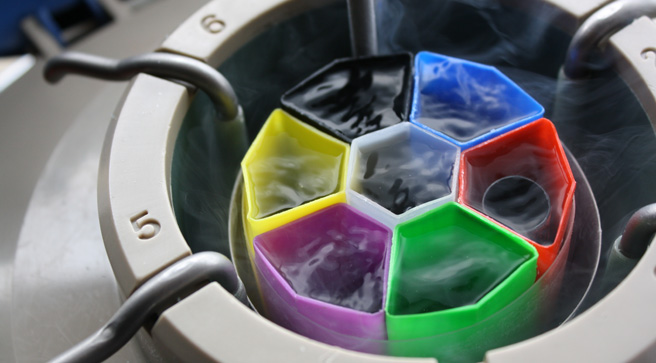
Advanced Vitrification Services
Freezing (or “cryopreservation”) of embryos is a common procedure. Since multiple eggs (oocytes) are often produced during ovarian stimulation, on occasion there are more embryos available than are considered appropriate for transfer to the uterus. These embryos, if viable, can be frozen for future use. This saves the expense and inconvenience of stimulation to obtain additional eggs in the future.
The availability of cryopreservation permits patients to transfer fewer embryos during a fresh cycle, reducing the risk of high-order multiple gestations (triplets or greater). Other possible reasons for cryopreservation of embryos include freezing all embryos in the initial cycle to prevent severe ovarian hyperstimulation syndrome (OHSS), or if a couple were concerned that their future fertility potential might be reduced due to necessary medical treatment and would like a backup plan.
Indications to Freeze Embryos:
- To reduce the risks of multiple gestation
- To preserve fertility potential in the face of certain necessary medical procedures
- To increase the chance of having one or more pregnancies from a single cycle of ovarian stimulation
- To minimize the medical risk and cost to the patient by decreasing the number of stimulated cycles and egg retrievals
- To temporarily delay pregnancy and decrease the risks of hyperstimulation (OHSS- see below) by freezing all embryos
Methods of Cryopreservations
There are several techniques for embryo cryopreservation. Traditional methods include “slow,” graduated freezing in a computerized setting, and “rapid” freezing methods, called “vitrification.” Current techniques deliver a very high percentage of viable embryos thawed after cryopreservation, but there can be no certainty that embryos will thaw normally, nor be viable enough to divide and eventually implant in the uterus.
Near East University IVF Centre uses vitrification for all of our egg – embryo freezing procedures. Vitrification, a flash-freezing method honed in Japan, has been in wide use for years now, and it is generally accepted to be the safest, most reliable method for freezing eggs/embryos. Part of the reason why vitrification is so much better than traditional “slow” freezing methods is that it is not, in fact, freezing in the traditional sense.
In IVF, vitrification refers to an advanced process of ultra-rapid embryo freezing that turns eggs/embryos into more of a glass-like structure, which then avoids ice-crystal formation, common in a traditional slow-freeze. By removing the possibility of ice-crystal formation, the primary threat to cell-health during a freezing process is able to be avoided.
